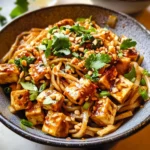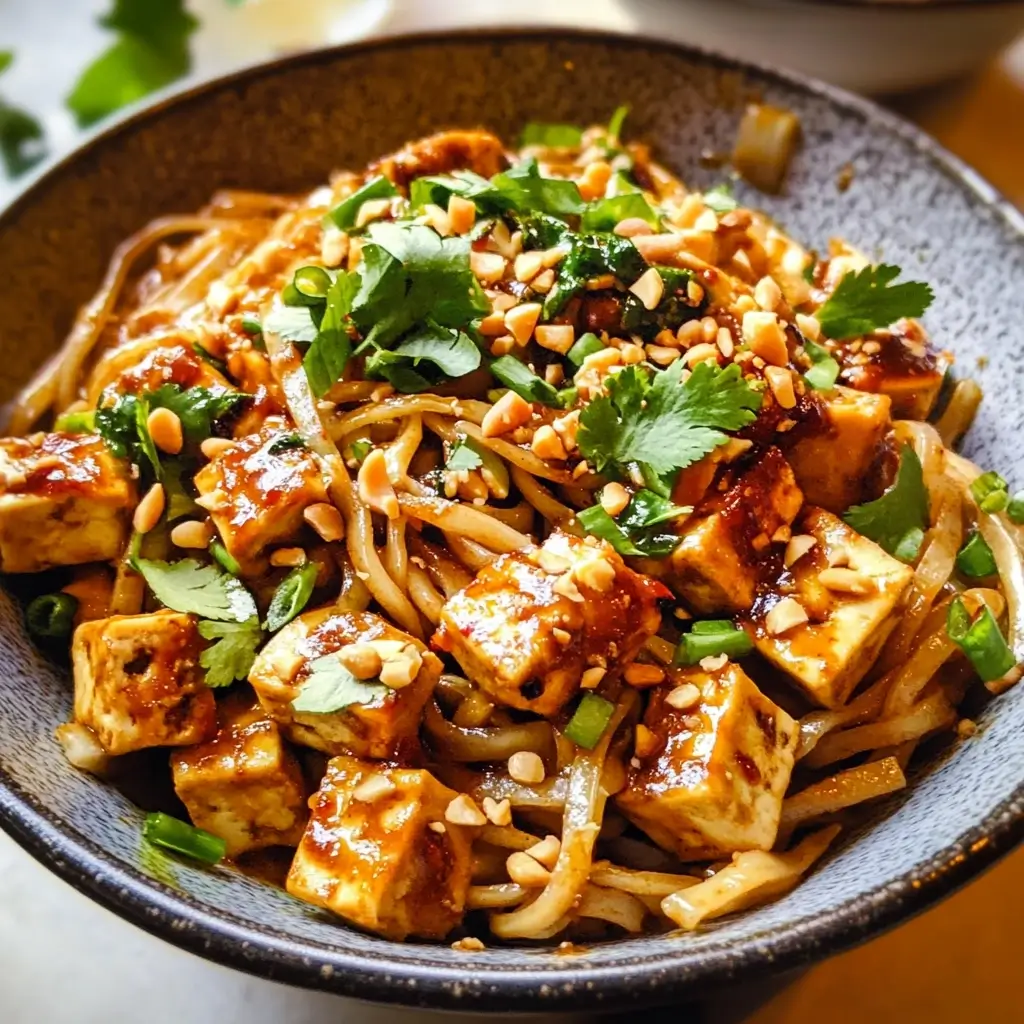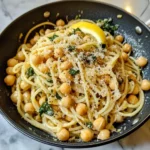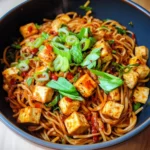There are some dishes that just instantly transport you, wrapping you in a comforting embrace of flavour and texture. For my family and me, this Thai Peanut Tofu Noodles recipe is exactly that. I remember the first time I nailed the sauce – that perfect balance of creamy peanut butter, tangy lime, savoury soy sauce, and just a hint of sweetness and spice. The aroma alone filled the kitchen, drawing everyone in with promises of deliciousness. When I finally served it, piled high with chewy noodles, crispy golden tofu cubes, and vibrant green cilantro, the reaction was unanimous: pure delight. My partner, usually reserved with praise, declared it “restaurant-worthy,” while the kids, often picky eaters, surprisingly devoured their portions, slurping up the peanutty noodles with infectious enthusiasm. It wasn’t just the taste, though; it was the satisfaction of creating something so flavourful and vibrant from relatively simple ingredients. It quickly became a staple in our meal rotation – perfect for busy weeknights when we crave something satisfying yet quick, ideal for meal prepping lunches that actually feel exciting, and even impressive enough to serve when friends come over. The combination of the rich, luscious peanut sauce clinging to every strand of noodle, the satisfying chew of the tofu, and the fresh counterpoints of lime and herbs is simply irresistible. It’s a dish that feels both indulgent and nourishing, a flavour explosion that proves vegan cooking can be incredibly exciting and deeply satisfying. This recipe isn’t just food; it’s a happy memory in a bowl, and I’m thrilled to share the version that won my family over completely.
Ingredients
Here’s what you’ll need to create this vibrant and satisfying dish:
- For the Crispy Tofu:
- 1 (14-16 oz) block extra-firm tofu: Drained and pressed thoroughly to remove excess water, then cut into ¾-inch cubes. Pressing is key for achieving a crispy texture.
- 1 tablespoon cornstarch (or arrowroot starch): This helps create a light, crispy coating on the tofu.
- 1 tablespoon soy sauce (or tamari for gluten-free): Adds savoury depth and helps the cornstarch adhere.
- 1 tablespoon neutral oil (like avocado, canola, or vegetable oil): For pan-frying the tofu to golden perfection.
- For the Peanut Sauce:
- ½ cup creamy peanut butter: Use a natural, unsweetened variety for the best flavour control. Ensure it’s well-stirred if natural separation has occurred.
- ⅓ cup warm water: To help blend the sauce to the desired consistency. You might need slightly more or less.
- ¼ cup low-sodium soy sauce (or tamari for gluten-free): The primary source of salty, umami flavour. Low-sodium allows better control.
- 2 tablespoons fresh lime juice: Adds essential brightness and tang to cut through the richness of the peanut butter. Roughly the juice of one lime.
- 2 tablespoons maple syrup (or agave nectar): Provides a touch of sweetness to balance the savoury and tangy elements. Adjust to your preference.
- 1 tablespoon rice vinegar: Adds another layer of acidity and complexity.
- 1-2 cloves garlic, minced: Fresh garlic provides pungent depth. Adjust amount based on your love for garlic.
- 1 teaspoon grated fresh ginger: Adds warmth and a zesty kick. A microplane works wonderfully here.
- ½ – 1 teaspoon Sriracha or chili garlic sauce (optional): For a touch of heat. Adjust the amount based on your spice tolerance.
- ½ teaspoon sesame oil (toasted preferred): Adds a distinct nutty aroma and flavour characteristic of many Asian dishes. A little goes a long way.
- For the Noodles & Assembly:
- 8 ounces dried noodles: Rice noodles (pad Thai style or linguine width work well), spaghetti, linguine, or ramen noodles are all great choices. Cook according to package directions.
- Optional additions: Steamed or stir-fried vegetables like broccoli florets, bell pepper strips, shredded carrots, snow peas, or baby spinach can be tossed in for extra nutrients and texture.
- Garnishes (highly recommended):
- Chopped fresh cilantro or Thai basil
- Chopped roasted peanuts
- Lime wedges
- Sliced green onions
- Red pepper flakes (for extra heat)
- Sesame seeds
Instructions
Follow these steps carefully for perfectly creamy noodles and crispy tofu:
- Prepare the Tofu: Ensure your tofu is well-pressed. Cut the pressed block into uniform ¾-inch cubes. In a medium bowl, gently toss the tofu cubes with 1 tablespoon of soy sauce (or tamari) until lightly coated. Sprinkle the cornstarch over the tofu and toss again gently until each piece is evenly dusted. This coating is crucial for crispiness. Avoid over-mixing, which can break the tofu.
- Cook the Tofu: Heat the 1 tablespoon of neutral oil in a large non-stick skillet or wok over medium-high heat. Once the oil is shimmering hot (a drop of water should sizzle), carefully add the coated tofu cubes in a single layer. Be cautious not to overcrowd the pan; cook in batches if necessary. Let the tofu cook undisturbed for 4-5 minutes per side, until golden brown and crispy. Use tongs or a spatula to carefully turn the cubes to brown all sides evenly. This process might take about 15-20 minutes in total for optimal crispiness. Once cooked, remove the tofu from the skillet and set it aside on a plate lined with paper towels.
- Cook the Noodles: While the tofu is cooking, bring a large pot of water to a boil. Add your chosen noodles and cook according to the package instructions until al dente (slightly firm to the bite). Be careful not to overcook, especially with rice noodles, which can become mushy quickly. Before draining, reserve about ½ cup of the starchy noodle water – this can be useful later for thinning the sauce if needed. Drain the noodles well and rinse briefly with cold water if using rice noodles to prevent sticking.
- Make the Peanut Sauce: While the noodles are cooking or the tofu is finishing up, prepare the sauce. In a medium bowl, combine the creamy peanut butter, warm water, low-sodium soy sauce (or tamari), fresh lime juice, maple syrup, rice vinegar, minced garlic, grated ginger, Sriracha (if using), and sesame oil. Whisk everything together vigorously until smooth and well combined. The warm water helps the peanut butter incorporate smoothly. The consistency should be pourable but thick enough to coat the noodles – like heavy cream. If the sauce seems too thick, whisk in a tablespoon or two of the reserved warm noodle water (or just warm water) until it reaches your desired consistency. Taste the sauce and adjust seasonings if necessary – add more lime for tang, maple syrup for sweetness, soy sauce for saltiness, or Sriracha for heat.
- Combine and Heat (Optional but Recommended): You have two main options here:
- Option A (Warm Sauce): Return the skillet used for the tofu to medium-low heat (no need to clean it unless there are burnt bits). Pour the prepared peanut sauce into the skillet and warm it gently for 1-2 minutes, stirring constantly. Don’t let it boil. Add the cooked and drained noodles to the skillet with the warm sauce. Toss gently but thoroughly until all the noodles are evenly coated. If adding extra vegetables like spinach or snow peas, you can toss them in here for a minute to wilt slightly.
- Option B (Room Temp/Cold Sauce): In a large serving bowl, combine the cooked and drained noodles with the prepared peanut sauce. Toss well to coat. This method works well if you prefer the dish served at room temperature or are using noodles like spaghetti that hold up well without reheating in sauce.
- Assemble the Dish: Divide the saucy noodles among serving bowls. Top generously with the crispy cooked tofu cubes.
- Garnish and Serve: Sprinkle with your chosen garnishes. Chopped cilantro, chopped roasted peanuts, and sliced green onions are highly recommended for flavour and texture contrast. Add a lime wedge to each bowl for squeezing over just before eating. Serve immediately and enjoy the explosion of flavours!
Nutrition Facts
This nutritional information is an estimate and can vary based on specific ingredients and portion sizes.
- Servings: This recipe typically makes 3-4 servings.
- Calories Per Serving: Approximately 550-650 kcal (based on 4 servings, can vary significantly with noodle type and sauce additions).
- Protein: Approximately 20-25g per serving. Tofu and peanut butter make this a high-protein vegan dish, crucial for satiety and muscle maintenance.
- Healthy Fats: Approximately 25-35g per serving. Primarily unsaturated fats from peanut butter, sesame oil, and cooking oil, which are beneficial for heart health.
- Fiber: Approximately 5-8g per serving. Contributed by the noodles (especially whole wheat or brown rice varieties), peanut butter, and any added vegetables, supporting digestive health.
- Carbohydrates: Approximately 60-75g per serving. Mainly from the noodles, providing energy. Choose whole grain or rice noodles for more complex carbohydrates.
(Note: These values are estimates. For precise nutrition information, consider using an online calculator with your specific ingredients and brands.)
Preparation Time
Enjoy this flavour-packed meal without spending hours in the kitchen.
- Prep time: Approximately 20 minutes (includes pressing tofu if not done ahead, chopping ingredients, whisking sauce).
- Cook time: Approximately 20-25 minutes (includes cooking tofu and boiling noodles).
- Total time: Approximately 40-45 minutes from start to finish, making it feasible for a weeknight dinner.
How to Serve
Presentation enhances the dining experience! Here are some ways to serve your Thai Peanut Tofu Noodles:
- Classic Bowl: Serve warm in individual shallow bowls, ensuring a good distribution of noodles, sauce, and crispy tofu.
- Garnish Power: Don’t skimp on the garnishes! They add crucial texture and freshness.
- Crunch: Chopped roasted peanuts are almost essential.
- Freshness: Generous amounts of fresh cilantro or Thai basil.
- Zing: Sliced green onions (both white and green parts).
- Acidity: A fresh lime wedge on the side of each bowl for squeezing.
- Heat: A sprinkle of red pepper flakes or a drizzle of chili oil for spice lovers.
- Nutty Hint: A sprinkle of toasted sesame seeds.
- Add Veggies: Mix in lightly steamed or stir-fried vegetables directly with the noodles and sauce just before serving. Good options include:
- Broccoli florets
- Sliced red or yellow bell peppers
- Shredded carrots
- Snow peas or snap peas
- Edamame (shelled)
- Baby spinach (wilts easily into warm noodles)
- Bean sprouts (add right at the end for crunch)
- Side Dishes: Serve alongside complementary light sides like:
- A simple cucumber salad dressed with rice vinegar and sesame seeds.
- Vegan spring rolls or summer rolls.
- A light Asian-style slaw.
- Room Temperature Option: This dish is also delicious served at room temperature, making it great for potlucks, picnics, or packed lunches. If serving cold, you might need to thin the sauce slightly with a bit more water or lime juice as it can thicken upon cooling.
- Family Style: Serve on a large platter for a communal dining experience, allowing everyone to add their preferred amount of tofu and garnishes.
Additional Tips
Elevate your noodle game with these handy tips:
- Press Tofu Like You Mean It: Don’t underestimate the importance of pressing the tofu! Extra-firm tofu still holds a lot of water. Removing as much as possible ensures the tofu doesn’t just steam in the pan; it allows it to absorb flavour better and get truly crispy when fried or baked. Use a tofu press or wrap the block in paper towels/a clean kitchen towel, place it on a plate, and weigh it down with something heavy (like books or a cast iron skillet) for at least 30 minutes, or even longer if time permits. Change towels if they become saturated.
- Nail the Sauce Consistency: The perfect peanut sauce consistency is key. It should be pourable but thick enough to cling lovingly to the noodles. If it’s too thick (peanut butter brands vary), whisk in reserved warm pasta water, plain warm water, or a little extra lime juice, one tablespoon at a time, until it reaches the desired texture. If it’s too thin, you can gently simmer it for a few minutes (whisking constantly to prevent scorching) or whisk in a tiny bit more peanut butter. Remember it will thicken slightly as it cools.
- Don’t Overcook the Noodles: Mushy noodles are the enemy of a good noodle dish. Cook your noodles until just al dente (firm to the bite), especially if you plan to toss them in a warm sauce where they might cook slightly further. For rice noodles, rinsing them under cold water immediately after draining stops the cooking process and helps prevent them from clumping together.
- Taste and Adjust the Sauce: The provided sauce recipe is a great starting point, but taste preferences vary wildly! Before tossing with the noodles, taste the sauce. Does it need more saltiness (soy sauce/tamari)? More tang (lime juice/rice vinegar)? More sweetness (maple syrup)? More heat (Sriracha/chili flakes)? Don’t be afraid to tweak it until it tastes perfect to you.
- Get Creative with Add-Ins: This recipe is a fantastic base for customization. Bulk it up and add nutritional value by tossing in steamed, roasted, or stir-fried vegetables. Broccoli, bell peppers, carrots, mushrooms, zucchini, edamame, snow peas, and spinach all work beautifully. Add them towards the end of the cooking process.
- Batch Cook Tofu for Crispiness: If you’re doubling the recipe or just want maximum crispiness, cook the tofu in batches. Overcrowding the pan lowers the oil temperature and leads to steaming rather than frying, resulting in softer tofu. Give each cube space to brown properly on all sides.
- Make it Ahead / Meal Prep: This dish is great for meal prep! The sauce can be made up to 3-4 days in advance and stored in an airtight container in the refrigerator. Cooked noodles and tofu can also be stored separately. Reheat gently, potentially adding a splash of water to loosen the sauce. For best results when meal prepping, store the sauce, noodles, and tofu separately and combine just before eating or gently reheating. The garnishes should always be added fresh.
- Ingredient Temperature Matters (for Sauce): Using warm water when whisking the peanut sauce helps the peanut butter melt and emulsify smoothly, preventing clumps. If your peanut butter is very cold and stiff straight from the fridge, letting it sit at room temperature for a bit or even microwaving it for 10-15 seconds can make mixing easier.
FAQ Section
Here are answers to some frequently asked questions about this Thai Peanut Tofu Noodles recipe:
- Q: Can I make this recipe gluten-free?
- A: Absolutely! It’s very easy to make this dish gluten-free. Simply ensure you are using certified gluten-free tamari instead of regular soy sauce. Also, double-check that your noodles are gluten-free; rice noodles, glass noodles, or gluten-free spaghetti/linguine are excellent choices. All other core ingredients are typically naturally gluten-free, but always check labels if you have severe Celiac disease or sensitivity.
- Q: How can I adjust the spice level?
- A: You have full control over the heat! For a milder version, omit the Sriracha or chili garlic sauce entirely. For just a hint of warmth, start with the lower amount suggested (e.g., ½ teaspoon). If you love spice, increase the amount of Sriracha, add a pinch of cayenne pepper to the sauce, or garnish generously with red pepper flakes or fresh sliced chilies (like Thai bird’s eye chilies, used sparingly!).
- Q: I have a peanut allergy. Is there a good substitute?
- A: Yes, you can substitute the peanut butter with other nut or seed butters. Creamy almond butter or cashew butter are good alternatives, offering a similarly rich texture, though the flavour profile will change slightly. For a nut-free version, sunflower seed butter (sunbutter) or tahini (sesame paste) can work. Tahini will give it a more Mediterranean/Middle Eastern flavour twist, but it’s still delicious. You may need to adjust the other seasonings slightly when using substitutes to balance the flavour.
- Q: What’s the best type of tofu to use?
- A: Extra-firm or firm tofu is highly recommended. These types hold their shape well after pressing and develop a pleasant chewy or crispy texture when cooked. Silken or soft tofu will not work for this recipe as they will fall apart. Super-firm tofu, which often doesn’t require pressing, is also a great option if available.
- Q: Can I use a different type of noodle?
- A: Definitely! While rice noodles are traditional for Pad Thai style dishes, this sauce is versatile. Regular wheat spaghetti, linguine, fettuccine, ramen noodles, udon noodles, or even zucchini noodles (zoodles) for a low-carb option work well. Just cook according to package directions and be mindful that cooking times and textures will vary.
- Q: How should I store leftovers?
- A: Store leftover Thai Peanut Tofu Noodles in an airtight container in the refrigerator for up to 3-4 days. The sauce may thicken when cold. You can enjoy it cold, let it come to room temperature, or reheat gently. To reheat, use a microwave (stirring occasionally) or warm in a skillet over low heat. You may need to add a splash of water or lime juice to loosen the sauce while reheating. Note that the tofu will lose its crispiness upon refrigeration but will still be flavourful.
- Q: Can I bake the tofu instead of pan-frying it?
- A: Yes, baking is a great, less hands-on alternative for cooking the tofu. After tossing the pressed tofu cubes with soy sauce and cornstarch, spread them in a single layer on a baking sheet lined with parchment paper. Bake at 400°F (200°C) for 25-35 minutes, flipping halfway through, until golden brown and firm. It might not get quite as deeply crispy as pan-frying but is still delicious and uses less oil.
- Q: My peanut sauce is too thick/thin. How do I fix it?
- A: This is common as peanut butter consistency varies. If the sauce is too thick, whisk in warm water, warm reserved noodle water, or lime juice, one tablespoon at a time, until it reaches a smooth, pourable consistency (like heavy cream). If the sauce is too thin, you can either whisk in a bit more peanut butter or gently simmer the sauce in a saucepan over low heat for a few minutes, whisking constantly, to allow it to reduce and thicken slightly. Remember it thickens upon cooling.

Thai Peanut Tofu Noodles
- Total Time: 45 minutes
Ingredients
Here’s what you’ll need to create this vibrant and satisfying dish:
- For the Crispy Tofu:
- 1 (14-16 oz) block extra-firm tofu: Drained and pressed thoroughly to remove excess water, then cut into ¾-inch cubes. Pressing is key for achieving a crispy texture.
- 1 tablespoon cornstarch (or arrowroot starch): This helps create a light, crispy coating on the tofu.
- 1 tablespoon soy sauce (or tamari for gluten-free): Adds savoury depth and helps the cornstarch adhere.
- 1 tablespoon neutral oil (like avocado, canola, or vegetable oil): For pan-frying the tofu to golden perfection.
- For the Peanut Sauce:
- ½ cup creamy peanut butter: Use a natural, unsweetened variety for the best flavour control. Ensure it’s well-stirred if natural separation has occurred.
- ⅓ cup warm water: To help blend the sauce to the desired consistency. You might need slightly more or less.
- ¼ cup low-sodium soy sauce (or tamari for gluten-free): The primary source of salty, umami flavour. Low-sodium allows better control.
- 2 tablespoons fresh lime juice: Adds essential brightness and tang to cut through the richness of the peanut butter. Roughly the juice of one lime.
- 2 tablespoons maple syrup (or agave nectar): Provides a touch of sweetness to balance the savoury and tangy elements. Adjust to your preference.
- 1 tablespoon rice vinegar: Adds another layer of acidity and complexity.
- 1–2 cloves garlic, minced: Fresh garlic provides pungent depth. Adjust amount based on your love for garlic.
- 1 teaspoon grated fresh ginger: Adds warmth and a zesty kick. A microplane works wonderfully here.
- ½ – 1 teaspoon Sriracha or chili garlic sauce (optional): For a touch of heat. Adjust the amount based on your spice tolerance.
- ½ teaspoon sesame oil (toasted preferred): Adds a distinct nutty aroma and flavour characteristic of many Asian dishes. A little goes a long way.
- For the Noodles & Assembly:
- 8 ounces dried noodles: Rice noodles (pad Thai style or linguine width work well), spaghetti, linguine, or ramen noodles are all great choices. Cook according to package directions.
- Optional additions: Steamed or stir-fried vegetables like broccoli florets, bell pepper strips, shredded carrots, snow peas, or baby spinach can be tossed in for extra nutrients and texture.
- Garnishes (highly recommended):
- Chopped fresh cilantro or Thai basil
- Chopped roasted peanuts
- Lime wedges
- Sliced green onions
- Red pepper flakes (for extra heat)
- Sesame seeds
Instructions
Follow these steps carefully for perfectly creamy noodles and crispy tofu:
- Prepare the Tofu: Ensure your tofu is well-pressed. Cut the pressed block into uniform ¾-inch cubes. In a medium bowl, gently toss the tofu cubes with 1 tablespoon of soy sauce (or tamari) until lightly coated. Sprinkle the cornstarch over the tofu and toss again gently until each piece is evenly dusted. This coating is crucial for crispiness. Avoid over-mixing, which can break the tofu.
- Cook the Tofu: Heat the 1 tablespoon of neutral oil in a large non-stick skillet or wok over medium-high heat. Once the oil is shimmering hot (a drop of water should sizzle), carefully add the coated tofu cubes in a single layer. Be cautious not to overcrowd the pan; cook in batches if necessary. Let the tofu cook undisturbed for 4-5 minutes per side, until golden brown and crispy. Use tongs or a spatula to carefully turn the cubes to brown all sides evenly. This process might take about 15-20 minutes in total for optimal crispiness. Once cooked, remove the tofu from the skillet and set it aside on a plate lined with paper towels.
- Cook the Noodles: While the tofu is cooking, bring a large pot of water to a boil. Add your chosen noodles and cook according to the package instructions until al dente (slightly firm to the bite). Be careful not to overcook, especially with rice noodles, which can become mushy quickly. Before draining, reserve about ½ cup of the starchy noodle water – this can be useful later for thinning the sauce if needed. Drain the noodles well and rinse briefly with cold water if using rice noodles to prevent sticking.
- Make the Peanut Sauce: While the noodles are cooking or the tofu is finishing up, prepare the sauce. In a medium bowl, combine the creamy peanut butter, warm water, low-sodium soy sauce (or tamari), fresh lime juice, maple syrup, rice vinegar, minced garlic, grated ginger, Sriracha (if using), and sesame oil. Whisk everything together vigorously until smooth and well combined. The warm water helps the peanut butter incorporate smoothly. The consistency should be pourable but thick enough to coat the noodles – like heavy cream. If the sauce seems too thick, whisk in a tablespoon or two of the reserved warm noodle water (or just warm water) until it reaches your desired consistency. Taste the sauce and adjust seasonings if necessary – add more lime for tang, maple syrup for sweetness, soy sauce for saltiness, or Sriracha for heat.
- Combine and Heat (Optional but Recommended): You have two main options here:
- Option A (Warm Sauce): Return the skillet used for the tofu to medium-low heat (no need to clean it unless there are burnt bits). Pour the prepared peanut sauce into the skillet and warm it gently for 1-2 minutes, stirring constantly. Don’t let it boil. Add the cooked and drained noodles to the skillet with the warm sauce. Toss gently but thoroughly until all the noodles are evenly coated. If adding extra vegetables like spinach or snow peas, you can toss them in here for a minute to wilt slightly.
- Option B (Room Temp/Cold Sauce): In a large serving bowl, combine the cooked and drained noodles with the prepared peanut sauce. Toss well to coat. This method works well if you prefer the dish served at room temperature or are using noodles like spaghetti that hold up well without reheating in sauce.
- Assemble the Dish: Divide the saucy noodles among serving bowls. Top generously with the crispy cooked tofu cubes.
- Garnish and Serve: Sprinkle with your chosen garnishes. Chopped cilantro, chopped roasted peanuts, and sliced green onions are highly recommended for flavour and texture contrast. Add a lime wedge to each bowl for squeezing over just before eating. Serve immediately and enjoy the explosion of flavours!
- Prep Time: 20 minutes
- Cook Time: 25 minutes
Nutrition
- Serving Size: one normal portion
- Calories: 650
- Fat: 35g
- Carbohydrates: 75g
- Fiber: 8g
- Protein: 25g






